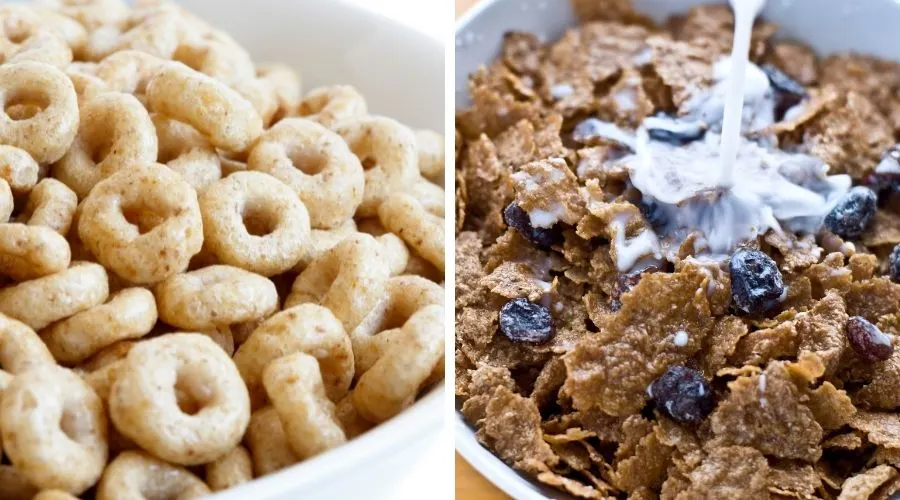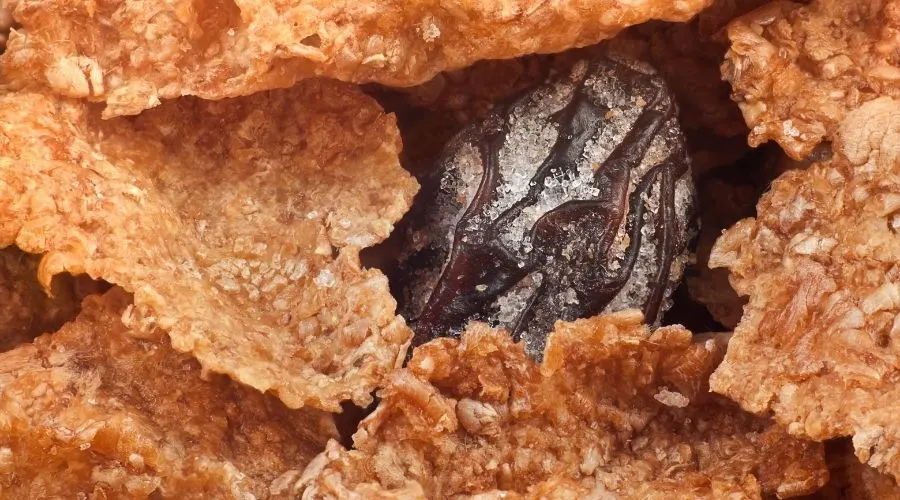When it comes to choosing a breakfast cereal, it’s only natural that you’d want to pick the best, especially when it comes to sugar content and fiber.
Both Cheerios and Raisin Bran are marketed as nutritious breakfast cereals that are heart-healthy. But does this come at the cost of something else, such as sugar, and is one better than the other?
In this article, I’ll be comparing Original Cheerios against Raisin Bran to find out the difference between the two, which is best for nutrition and which one is better value for money.
Also in This Article
In a hurry, or looking for something specific? Use the links below to jump to the relevant section:
- Ingredients Comparison
- Cheerios Vs. Raisin Bran Nutritional Comparison:
- Best for Calorie Content
- Best for Carbs & Sugar Content
- Best for Protein Content
- Best for Fat Content
- Best for Fiber Content
- Best for Sodium/Salt Content
- Best for Vitamins/Minerals
- Best for Flavor/Texture
- Best for Price
- Overall Winner
Ingredients Comparision
The main difference between Original Cheerios and Raisin Bran is the main ingredient of the two. The main ingredient of cheerios is wholegrain oats compared to Raisin Bran which is made from whole grain wheat.
Both kinds of cereal contain relatively simple ingredients, and both have added sugar and salt.
| Original Cheerios Ingredients | Raisin Bran Ingredients |
| Whole Grain Oats, Corn Starch, Sugar, Salt, Tripotassium Phosphate. Vitamin E (mixed tocopherols) Added to Preserve Freshness. | Whole grain wheat, raisins, wheat bran, sugar, brown sugar syrup. Contains 2% or less of malt flavor, salt. |

Cheerios Vs. Raisin Bran Nutritional Comparison
Moving onto the nutritional comparison and there’re just a few things I need to mention before we start.
The recommended serving size of Original Cheerios is 39g. In contrast, a serving of Raisin Bran is 59g which is quite a big difference, so to keep the comparison fair and accurate, I’ll be comparing weight-for-weight (per 100g) but still including the serving data for information.
To confirm, the cereals I’m comparing are General Mills brand Original Cheerios Vs. Kellogg’s Raisin Bran.
Best for Calorie Content
Starting with the calorie comparison and of the two Raisin Bran contain fewer calories per weight than Original Cheerios.
Although a serving of Raisin Bran contains more calories, this is because it weighs more, but when compared per 100g, Raisin Bran contains 37 fewer calories than Original Cheerios.
| Cereal Type | Calories Per 100g | Calories Per Serving |
| Original Cheerios | 359kcal | 140kcal (per 39g serving) |
| Raisin Bran | 322kcal | 190kcal (per 59g serving) |
Best for Carbohydrate Content
Neither Original Cheerios nor Raisin Bran can be classed as low-carbohydrate breakfast options, but if this is something your tracking in your diet, then Cheerios contain fewer carbs per weight than Raisin Bran.
| Cereal Type | Carbohydrates Per 100g | Carbohydrates Per Serving |
| Original Cheerios | 74g | 29g (per 39g serving) |
| Raisin Bran | 80g | 47g (per 59g serving) |
Best for Sugar Content
One of the most significant differences between Original Cheerios and Raisin Bran is the sugar content, with Raisin Bran being much higher in sugar per weight.
A serving of Raisin Bran contains 17g of sugar, of which 9g is added sugar, and some that’s naturally occurring in the raisins.
Compared to Original Cheerios, which contain 2g of sugar per serving, making them the lower sugar option of the two.
| Cereal Type | Sugars Per 100g | Sugars Per Serving |
| Original Cheerios | 5g | 2g (per 39g serving) |
| Raisin Bran | 29g | 17g – 9g added sugar (per 59g serving) |
Best for Protein Content
Both kinds of cereal contain 5g of protein per serving, but because a serving of Raisin Bran weighs 20g more, weight-for-weight, Cheerios contain more protein than Raisin Bran.
| Cereal Type | Protein Per 100g | Protein Per Serving |
| Original Cheerios | 12.8g | 5g (per 39g serving) |
| Raisin Bran | 8.5g | 5g (per 59g serving) |
Best for Fat Content
Both Original Cheerios and Raisin Bran are low in fat, but of the two, Cheerios contain slightly more per weight.
Original Cheerios contain a small amount of saturated fat (0.5g) per serving, and neither Cheerios nor Raisin Bran contains any cholesterol.
| Cereal Type | Fat Per 100g | Fat Per Serving |
| Original Cheerios | 6.4g | 2.5g (per 39g serving) |
| Raisin Bran | 1.7g | 1g (per 59g serving) |

Best for Fiber Content
Besides sugar, fiber content is another important consideration for consumers when choosing a breakfast cereal.
When Comparing Original Cheerios and Raisin Bran for fiber content, they’re relatively similar, with Raisin Bran having slightly more (1.7g) fiber per 100g.
Although Raisin Bran wins best for fiber between them and Cheerios, they’re much higher in sugar, so it’s a case of weighing up whether the small amount of extra fiber is really worth the extra sugar.
| Cereal Type | Dietary Fibre Per 100g | Dietary Fibre per Serving |
| Original Cheerios | 10.3g | 4g (per 39g serving) |
| Raisin Bran | 12g | 7g (per 59g serving) |
Best for Sodium/Salt Content
When it comes to sodium content, Cheerios contain slightly more sodium per 100g than Raisin Bran (but slightly less per serving).
To put this into the context of a daily value, Cheerios contain 8% of the recommended daily amount, and Raisin Bran has 9% per serving.
| Cereal Type | Sodium/Salt Per 100g | Sodium/Salt per Serving |
| Original Cheerios | 487mg | 190mg (per 39g serving) |
| Raisin Bran | 339mg | 200mg (per 59g serving) |
Best for Vitamins/Minerals
Cheerios are a fortified breakfast cereal which means there are added vitamins and minerals in the ingredients. In contrast, Raisin Bran has naturally occurring vitamins and minerals from the cereals’ ingredients.
Although Raisin Bran contains plenty of nutrients, Cheerios has a broader range of vitamins and minerals with a higher daily value percentage in most categories.
The table below shows the vitamins and minerals for each kind of cereal and the daily value percentage of each one.
| Vitamin/Mineral Type | Original Cheerios Daily Value % | Raisin Bran Daily Value % |
| Vitamin D | 10% | – |
| Calcium | 10% | – |
| Iron | 70% | 10% |
| Phosphorus | 10% | 10% |
| Potassium | 6% | 6% |
| Magnesium | 15% | 15% |
| Thiamin | 20% | – |
| Riboflavin | – | – |
| Vitamin B6 | 20% | – |
| Vitamin C | 10% | – |
| Vitamin A | 10% | – |
| Vitamin B12 | 20% | – |
| Niacin | 10% | 15% |
| Folic Acid | 20% | – |
| Zinc | 20% | 10% |
| Selenium | – | 10% |
| Copper | – | 20% |
| Manganese | – | 80% |
*mcg = microgram (1000th of a milligram) / mg = milligram (1000th of a gram)
Best for Flavor/Texture
When it comes to which cereal is best for taste, both kinds of cereal taste very different, and it’s not easy to judge a winner without a general opinion.
Please vote in the poll below to tell us which is your favorite, so we can gather the data we need, and once you vote, the winner so far will be revealed.
Best for Price
Because Original Cheerios and Raisin Bran are sold in different-sized boxes, I’ve calculated the cost per ounce to ensure the comparison is fair.
Below are the average prices of each cereal per pack and per ounce:
- Original Cheerios 18oz box = $3.98 / 22¢ per ounce
- Original Cheerios 21.7oz box = $5.48 / 25¢ per ounce
- Raisin Bran 16.6oz box = $3.22 / 19¢ per ounce
- Raisin Bran 24oz box = $3.98 / 17¢ per ounce
Based on the data above, Raisin Bran costs less per ounce than Cheerios, making it the better value cereal of the two.
Please note that these prices were correct when this article was written, but they may fluctuate over time and vary with offers and prices per store.
Overall Winner
We’ve compared all categories for nutrition and price, things were pretty close, but I can now reveal the winner of most categories is – Raisin Bran.
Compared to Original Cheerios, Raisin Bran came in top for lowest in calories, sodium, and fat while being highest in fiber, and it also costs less per ounce.
This was a close contest, and Cheerios came in as lowest in carbs and sugar and highest in vitamins and minerals.
It really comes down to what is most important to you and your diet because although Raisin Bran is best for fiber, it’s also much higher in sugar. Hopefully, you can use the data in this article to decide which is best for you.
| Comparison Category | Winner (Original Cheerios or Raisin Bran) |
| Best for Calorie Content | Raisin Bran |
| Best for Carbohydrate Content | Cheerios |
| Best for Sugar Content | Cheerios |
| Best for Protein Content | Cheerios |
| Best for Fat Content | Raisin Bran |
| Best for Fiber Content | Raisin Bran |
| Best for Sodium Content | Raisin Bran |
| Best for Vitamins/Minerals | Cheerios |
| Best for Price | Raisin Bran |
| Overall Winner | Raisin Bran |
Related Articles
I hope this article has helped you to find the information you were looking for; you might also find the following articles helpful too:
Special K Vs. Cheerios (Which is Best?)
Cinnamon Toast Crunch Vs. Frosted Flakes
Canned Sweet Potatoes Versus Fresh Sweet Potatoes (Which Is Better)
References Used for this Article
To ensure the nutritional information used in this article is accurate, I have used data from the manufacturer; the links below contain the source information:
